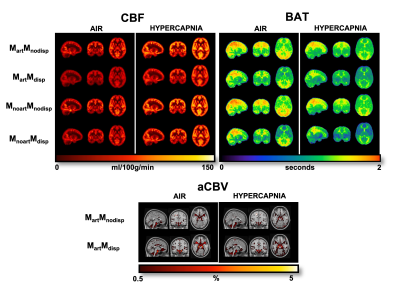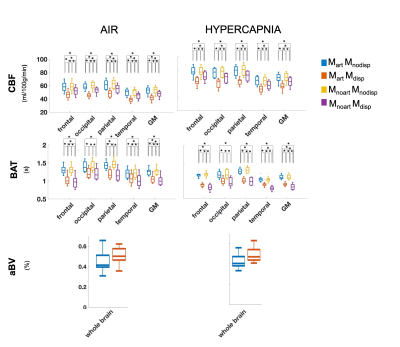Joana Pinto1, Nicholas P. Blockley2, James W. Harkin3, and Daniel P. Bulte1
1Institute of Biomedical Engineering, Department of Engineering Science, University of Oxford, Oxford, United Kingdom, 2School of Life Sciences, University of Nottingham, Nottingham, United Kingdom, 3Respiratory Medicine Department, School of Medicine, University of Nottingham, Nottingham, United Kingdom
1Institute of Biomedical Engineering, Department of Engineering Science, University of Oxford, Oxford, United Kingdom, 2School of Life Sciences, University of Nottingham, Nottingham, United Kingdom, 3Respiratory Medicine Department, School of Medicine, University of Nottingham, Nottingham, United Kingdom
Our results highlight the importance of multiple-PLD ASL strategies for accurate CBF and CVR quantification. Furthermore, when using this strategy, the modelling options used significantly impact CBF quantification, regardless of the condition studied.

Figure 1. Orthogonal representations of CBF, BAT, and aCBV maps of one subject for the different modelling strategies and conditions (air and hypercapnia). aCBV maps are only obtained when using strategies where the macrovascular component is modelled (Mart). MartMnodisp - model with macrovascular component but without dispersion, MartMdisp - model with macrovascular and dispersion components, MnoartMnodisp - model without macrovascular and dispersion components, MnoartMdisp - model with dispersion but without macrovascular component.

Figure 2. Regional analysis of the different haemodynamic parameters (CBF, BAT and aBV; rows) with the different modelling strategies (colors, correspondence detailed in Figure 1 legend) and conditions (columns). Statistically significant results are highlighted with * (p>0.05, corrected for multiple comparisons).
